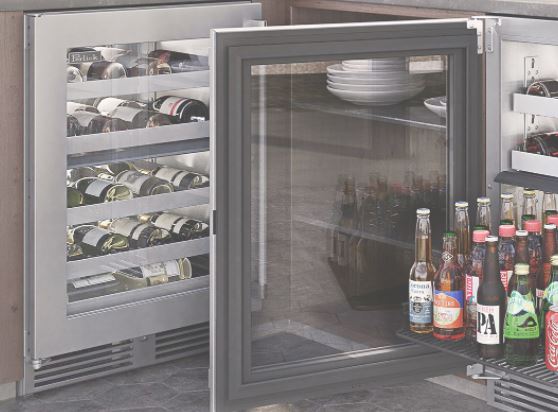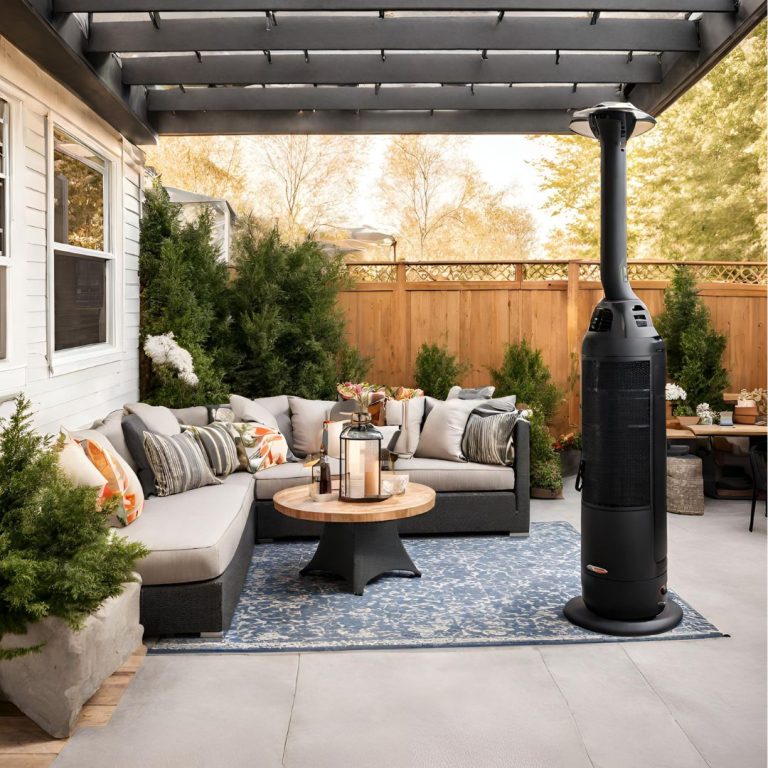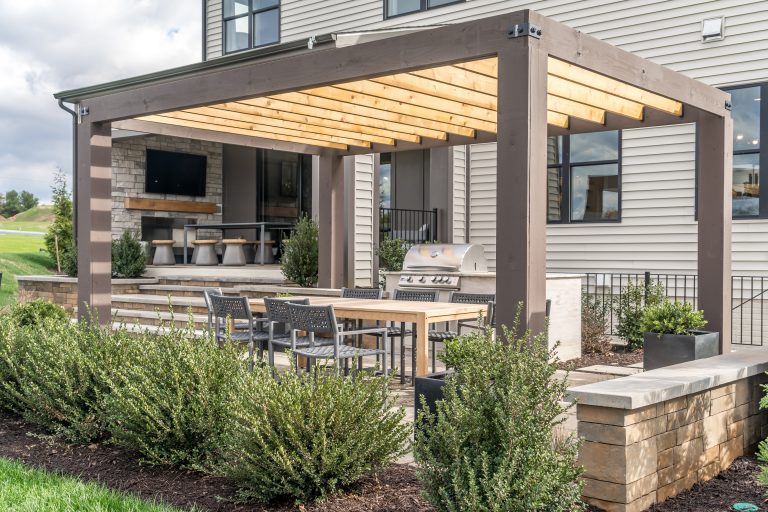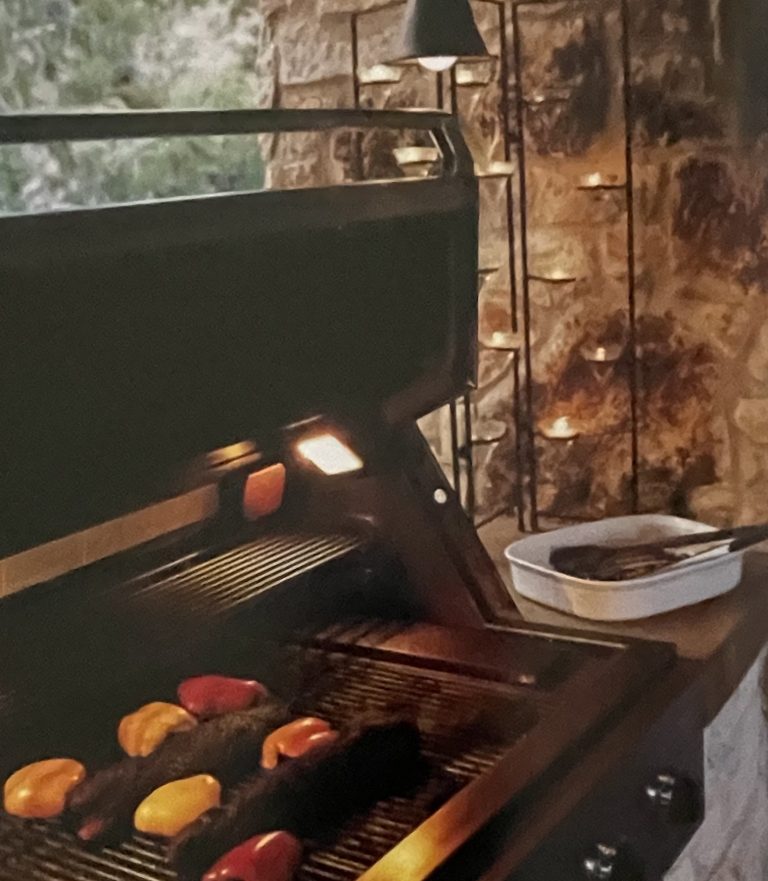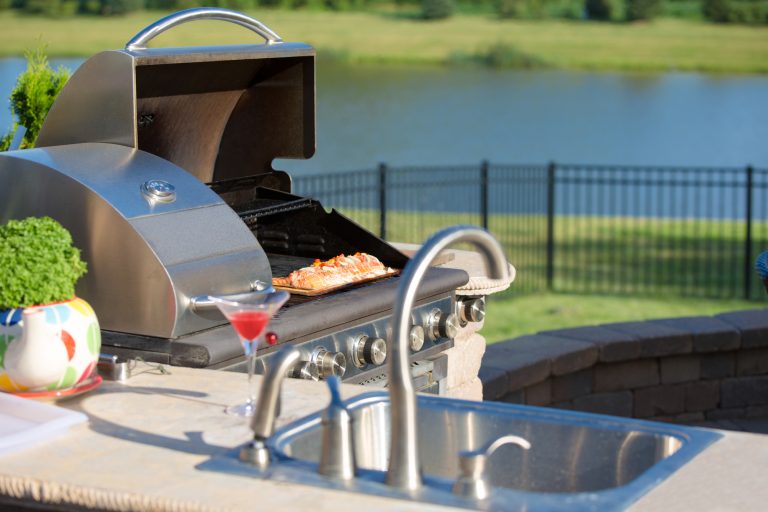How Much Energy Does an Outdoor Wine Refrigerator Use?
Your dream outdoor kitchen or bar may not be quite complete. What is it missing? It might be missing a builtin wine refrigerator. It’s the final touch to your masterpiece. The item that will put functionality and appearance over the top.
A built in wine cooler is a lot better looking than your average outdoor ice maker. First of all, it has those attractive glass doors with LED lighting that cast a calm blue glow over the stainless steel finishes. And unlike a wine cellar with custom wine racks located in your basement that no one might ever see, this appliance for storing wine is something everyone will see, and be suitably impressed.
However, all that impressive technology will come at a price. The cost of the wine fridge is the initial down payment to the dream, but what are the electricity costs associated with this purchase?
You might be surprised that the power consumption and electricity usage won’t affect your utility bills by very much. In fact, you may not notice the monthly change at all.
Below we will answer your questions about wine refrigerators and specifically, how an outdoor wine fridge operates when the outdoor temperature range is so wide.
How Much Electricity Does an Outdoor Wine Fridge Use?
You needn’t delay getting an outdoor wine refrigerator over concerns about energy consumption. In fact, an outdoor wine refrigerator can be quite energy efficient if you know which type of wine cooler to buy and how to situate it to minimize energy usage.
What Is Wattage? And How Does It Work?
The driving force that causes electrical current to flow in a circuit is voltage. A circuit’s wattage is the amount of energy it consumes. The product of voltage and current is power.
Watts are simply units of measurement for electricity. They indicate how much energy an electrical device consumes. Every electrical device in your outdoor kitchen has a sticker that indicates its wattage power.
Watts are also used to calculate your energy consumption. You’ll see kilowatt-hour (kWh) listed prominently on your electricity bill when it arrives at the end of the month.
Sample Outdoor Fridge Wattage
Different Models, Different Wattage
When you are looking for an outdoor refrigerator, cooler or beverage chiller, experts recommend one with an Energy Star rating. Appliances that carry this rating will use fewer watts to cool the interior of the fridge and will therefore cost less to run.
Older outdoor appliances without this rating will use more watts to do the exact same job. They also won’t be equipped with the amount of insulation newer models have and won’t be equipped with LED lighting which also uses less energy.
It stands to reason, therefore, that larger appliances with more electrical features will use even more watts than smaller ones. There is more air to chill, so the mechanics are larger and more powerful and need more power to do their job. This means that a 100 bottle capacity wine fridge will use more energy than a 40 capacity wine fridge because there is simply more cold air to chill.
How Many Watts Does My Outdoor Fridge Use?
Every outdoor kitchen appliance, including outdoor refrigeration devices, have a label somewhere on the unit which will tell you the predicted energy consumption for your particular model. In some models, it is located on the back panel, in others it is on the inside of the door panel. It looks something like this:
As you scroll down the details, you will see the estimated cost of running this appliance for one year.
What is the most efficient outdoor wine cooler in terms of size?
Small Outdoor Wine Fridges – 15-17″
The thermoelectric fridge is more efficient in terms of electricity usage if you choose a small device with a capacity of less than 30 bottles. A 28-bottle thermoelectric cooler, for example, consumes only 70 watts on average, but a compressor unit of the same capacity consumes 85 watts.
Both will have a minor influence on your monthly payment, but the thermoelectric refrigerator will save you money.
Large Wine Refrigerators – 20″-48″
If you need a larger fridge with a capacity of more than 30 bottles, a compressor technology system comes into play. Because there is a little difference in internal capacity between the two units, the compressor system still uses 85 watts in the next size up, which is a 32-bottle wine fridge.
The thermoelectric units, on the other hand, demand double the power, with a 32-bottle thermoelectric wine fridge using 140 watts on average.
The cooling system is to blame for such a large disparity. The compressor fridges can cool 28 or 32 bottles with the same capacity compressor. A larger thermoelectric system, on the other hand, will require more cooler modules to chill the air in a larger cabinet.
Outdoor Fridge vs Outdoor Wine Cooler vs Outdoor Beverage Cooler: Energy Consumption
As far as electrical appliances go, wine coolers aren’t the most energy efficient. Wine coolers, unlike televisions, are always on and must keep a steady temperature. The good news is that you can compare apples to apples with other outdoor wine coolers to choose the one that is most energy efficient.
When shortlisting your favorite wine refrigerators, compare not only the purchase price and bottle capacity, but also the kWh/year calculation number and the expected annual cost. This figure represents the actual power consumption in kWh per year and an estimate of that cost, and it may vary slightly depending on the cost of electricity in your location.
Are Outdoor Wine Fridges Energy-Efficient?
Compared with other electrical refrigerating appliances you may use outdoors, an outdoor wine refrigerator falls somewhere in the middle of electricity usage. Purchasing an Energy Star rated appliances for your outdoor kitchen will keep you electrical usage to a minimum.
Thermoelectric technology devices are always on and are affected by the temperature outside. They will work at a higher capacity to reach the desired temperature if it is too hot. This leads to increased energy consumption.
Regardless of how hot it gets, compressor refrigerators work the same way. You may put your wine refrigerator in the middle of a desert and receive the same cooling performance and energy usage as you would at home.
How Much Does It Cost to Run an Outdoor Wine Fridge?
| Refrigeration Type | Electrical Amps | kWh/year | Cubic feet | Estimate yearly cost at $.129 per kWh |
| 24″ Outdoor Fridge | .8 | 250.0 | 4.6 | $32 |
| 24″ Outdoor Wine Cooler | .9 | 844.0 | 4.5 | $108 |
| 24″ Outdoor Beverage Cooler | 1.8 | |||
| 24″ Outdoor Kegerator | 1.25 | 305.00 | 5.6 | $39 |
Top Tips for Lowering Your Outdoor Wine Fridge Power Bill
Choose a Single Zone Wine Cooler
A dualzone wine cooler has two separate zones because it has two separate compartments. Each can be individually controlled temperature-wise and this consumes more energy.
Keep the Door Closed
The more the door is opened and closed, the more the cooler has to work to restore the target temperature. Having a lock on the door will help cut down on access and ensure that the door is tightly closed at all times.
Don’t Leave the Doors Open for Long
Know what you are after before opening the wine cooler door. It helps if your cooler has a glass insert in the door. You can see exactly where the vintage you are after is located and you can quickly remove it without keeping the doors open while you decide what you want and where it might be racked.
Stack Items Efficiently
An overstuffed wine fridge will not cool efficiently. Most models of outdoor wine refrigerators will have a bottle capacity listed plainly on the model’s literature. Cool air needs to circulate to perform its chilling function efficiently. If you restrict air flow by overfilling the cooler, the unit will have to work harder to maintain the proper temperature.
Clean the Wine Fridge, Inside and Out
Outdoor wine fridges will need more cleaning maintenance than indoor ones typically require. Debris, leaves, dirt, sand and the like can quickly accumulate around and under the unit which may restrict ventilation. When this happens, the unit struggles to work properly. Most manufacturers recommend cleaning the outdoor wine cooler at least twice a year, more often if yours is located in a windy area or there are lots of pets around.
Should any spillage occur, the best thing to do is to clean the interior of the fridge as quickly as possible. This will make sure that the interior surfaces don’t become permanently blemished.
Keep It Away from Heat Sources
A refrigerator keeps wine chilled, but it isn’t a complete weatherproofing system. Direct sunshine is extremely hot, and it has an effect on the wine refrigerator’s ability to keep the contents chilled. This is especially true for a thermoelectric refrigerator, which struggles in hot weather.
Direct sunlight and heat on a wine fridge can cause a variety of problems that will cost you money:
- Wine refrigerators that work harder demand more electricity to maintain a consistent temperature.
- If UV rays can penetrate the fridge in any way, the wine’s components will be broken down.
- The exterior of the fridge can be damaged, and more extreme temperature variations can prevent it from working at all.

